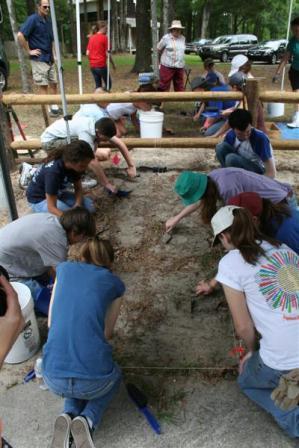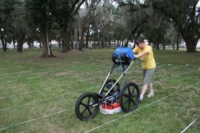Digs in the 1800s and 1900s
1894 – Clarence B. Moore SAND MOUNDS
The celebrated Clarence B. Moore made extensive sweeps of Florida searching for Indian mounds. When he located one, he excavated it and cataloged the artifacts. While researching mounds along the St. Johns River, he used the Magnolia Springs Hotel (north of Governor’s Creek) as his base.
Volume 2 of his Certain Sand Mounds of the St. John’s River contains his findings in Clay County. While reading it at Google Books, search for “Clay County” to find the relevant pages.
Except, that is, for the mound on Peoria Rd. James Silcox, the owner, wanted to charge him for access, and Moore refused to pony up. On a later trip, Silcox did agree to allow a dig, but Moore found few artifacts. This is published in his Additional Mounds describes this “mound at Peoria.”
There is a debate whether his methods were “scientific enough,” but what is sure is that many, or most, of the mounds would have been destroyed by the time better science came along.
1916 – Thomas & Kendrick – MAGNOLIA SPRINGS
Apparently Thomas & Kendrick, guests at the Magnolia Springs Hotel, excavated a sand mound on the grounds. Read the article and decide for yourself whether they really found a 6 foot 6 inch skeleton, or whether it was a hoax put on by the hotel proprietor. The artifacts they found have not been located.
1951 – John M. Goggin – FORT PUPO
Professor Goggin performed an extensive dig at Fort Pupo. This was an especially important dig because much of the Pupo (Pupa) area has eroded into the St. Johns River.
The results of his dig are documented in Florida Historical Quarterly Vol. 30, No. 2, Oct. 1951 “Fort Pupo: A Spanish Frontier Outpost.”.
FPAN is considering another dig, fifty years later.
1992 – The Maple Leaf Underwater Excavation
The Maple Leaf, a Civil War ship on the National Register of Historic Places, was excavated in 1992. Artifacts are at the Jacksonville Museum of Science and History. Reports: Loss of the Maple Leaf. National Register Nomination (pre-dig). Report of the Excavation is published in “The Maple Leaf: An extraordinary American Civil War Shipwreck,” available at the Archive, and a replica of the torpedo that sank her is on display.
1996 – Reinterment of Civil War soldiers at Gadera
1997 – Brickyard, Gamble and Stockton Co.
Digs after 2000
2004 – Camp Blanding Surveys
Ft. Heileman Site Survey
2007 – Camp Blanding Surveys
More than fifteen projects were completed at Camp Blanding since 2007. None of the surveys showed potential for inclusion on the National Register of Historic Places. The Archives is in the midst of acquiring the reports.
2009 – FPAN – Magnolia Springs Cemetery
2010 – Middleburg Bricks
 In 2009, while running, a local resident noticed some erosion along the road to the Middleburg boat ramp. Several bricks had been exposed. This is the general area of Ft. Heileman — the Seminole War fort.
In 2009, while running, a local resident noticed some erosion along the road to the Middleburg boat ramp. Several bricks had been exposed. This is the general area of Ft. Heileman — the Seminole War fort.
In an effort to determine whether the bricks were as old as the 1830s, an archaeological dig was launched in partnership between the Historical Commission and the FPAN. Read their blog and newsletter for a synopsis of the day.

Two brief papers may also be of interest. A was prepared by Kevin Hooper. And brick making in North Florida has been explored by John Nelson.



